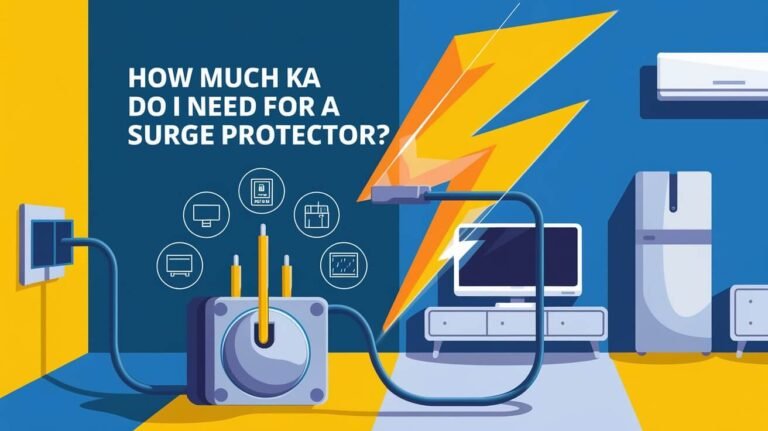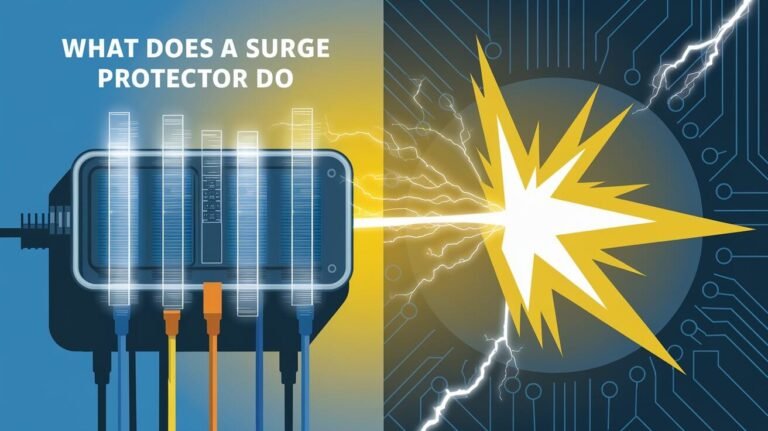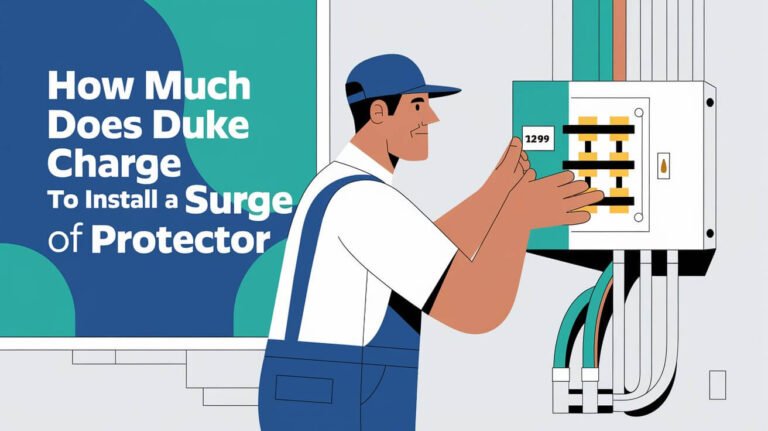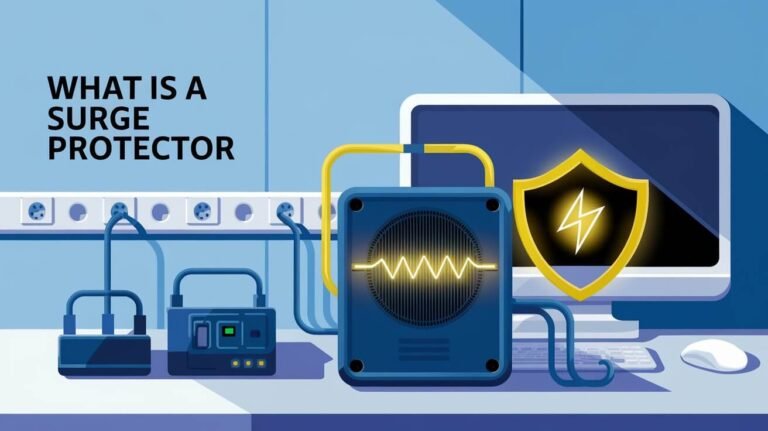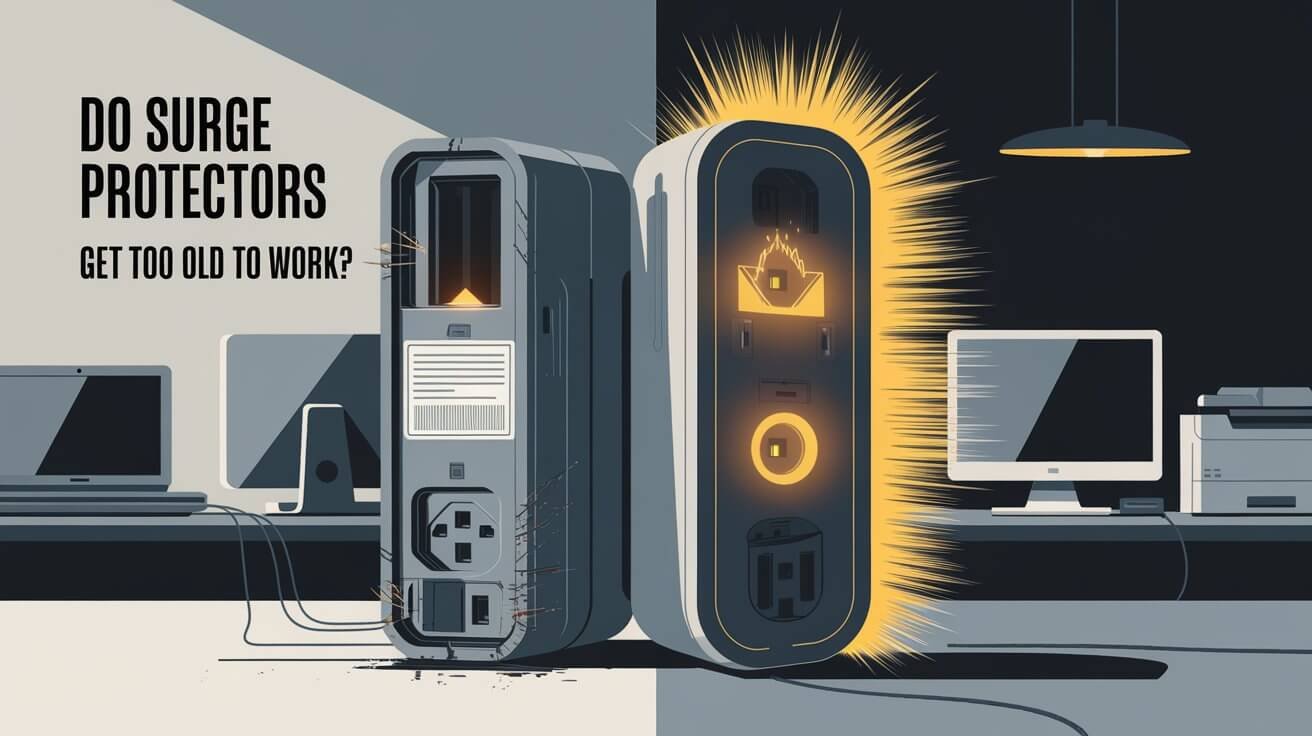
Surge protectors are key in keeping electronic devices safe from power surges. They absorb sudden electrical power, like hundreds of small surges daily. Over time, this can reduce their effectiveness, putting devices at risk.
It’s vital to know how surge protectors work and what affects their lifespan. This knowledge helps keep devices safe and ensures surge protectors work well for longer.
Lifespan Reality of Surge Protectors
Surge protectors are key in keeping our electronics safe from power spikes. But, they can wear out over time. This is due to several reasons, like repeated exposure to power surges. The lifespan of Metal Oxide Varistors (MOVs) is also important, as they handle the extra energy.
Power fluctuations can really take a toll on surge protectors. As they soak up sudden electrical bursts, they can start to break down. This makes them less effective at shielding our devices from power surges. Let’s look at what affects how long surge protectors last:
- Physical component deterioration: Over time, the physical parts of surge protectors can wear out, making them less effective.
- MOV degradation: The lifespan of MOVs is key, as they absorb extra energy.
- Power fluctuation effects: Regular power changes can greatly shorten the life of surge protectors.
Knowing these factors helps us keep our surge protectors working well. This way, they can keep our electronics safe from power surges and changes.
| Surge Protector Type | Cost | Protection Level |
|---|---|---|
| Whole-house surge protectors | $100-$200 | 20,000-40,000 amps |
| Quality power strip surge protectors | $20-$70 | 600 joules or higher |
| UPS systems | $100-$350 | Varying capacities |
Signs Your Surge Protector Needs Replacement
Surge protectors are key in keeping your electronics safe from power surges. But, they don’t last forever and may need to be replaced. Knowing when to replace your surge protector is vital to keep your devices safe. A common sign is when the LED diagnostics fail, showing the surge protector is no longer working.
Signs of a failing surge protector can be hard to spot. But, look out for devices that keep shutting down or not working right. Some surge protectors might keep working but not protect against surges. Using too many devices on one can also cause it to fail, so be careful.
To know if your surge protector needs a new one, watch for these signs:
- LED notifications showing a surge protection fault
- Visible damage like burn marks or frayed cords
- Devices often failing or not working right
- A big power hit, like lightning, in your area
Replace your surge protector every two years or right after a big power hit. This keeps your devices safe from power surges. By watching for these signs and acting fast, you can protect your electronics.
| Surge Protector Type | Replacement Interval | Key Features |
|---|---|---|
| Point-of-use protectors | 2-3 years | LED diagnostics, grounded and protected indicators |
| Whole-house protectors | 5-7 years | Comprehensive protection for all devices, higher-end features like USB ports and Ethernet jacks |
Hidden Damage Inside Surge Protectors
Surge protectors wear out with each power surge they block. The more surges they face, the less they can handle. This wear and tear can make them less effective over time.
Thermal stress also harms surge protectors. When they absorb energy from surges, they can get hot. This heat can damage their parts, making them less able to protect against future surges.
Several factors can affect how well a surge protector works:
- Power surge frequency and intensity
- Quality of the surge protector
- Aging of the surge protector’s internal components
Knowing about the hidden damage in surge protectors helps homeowners. They can replace their surge protectors often. This keeps their electronic devices safe from power surges.
| Surge Protector Age | Effectiveness | Recommended Action |
|---|---|---|
| 0-2 years | High | No action needed |
| 2-5 years | Medium | Monitor performance |
| 5+ years | Low | Replace surge protector |
Testing Your Surge Protector’s Effectiveness
To make sure your surge protector works well, it’s key to check it often. Look for a blinking light, which might mean it’s time for a new one. You can also test it by plugging a device in and seeing if it gets power. But remember, surge protectors don’t last forever. They usually need to be replaced every three to five years.
Some surge protectors have LED lights or sound alarms to show if there’s a problem. If it stops working right, it won’t protect your devices from power surges. This could harm your electronics. To check if your surge protector is doing its job, look at the manufacturer’s specs or for a mark from a trusted testing group.
Be careful not to overload your surge protector. This can cause damage and make it less effective. By using testing methods and doing DIY checks, you can keep your devices safe from power surges. Here are some things to watch for:
- Visible indicators of wear or damage
- LED lights or audio alarms indicating a fault
- Manufacturer’s specifications for protection level verification
Common Myths About Surge Protector Aging
Surge protectors are often misunderstood. Many myths surround their aging process. One myth is that they can protect against direct lightning strikes. This is not true.
Surge protectors are designed to safeguard against power surges caused by lightning strikes. But they cannot withstand a direct hit.
Another myth is that all surge protectors are created equal. This is not true. Different appliances need surge protectors with varying joule ratings. Using the wrong one can lead to inadequate protection.
For example, high-power devices like air conditioners and refrigerators need surge protectors with higher joule ratings. This prevents damage from power surges.
Debunking Protection Level Misconceptions
Many people believe a higher joule rating means better protection. But this is not always the case. The right joule rating depends on the device being protected and the surge protection needed.
Warranty misunderstandings are also common. Many people think a longer warranty means better protection. But this is not necessarily true.
- Surge protector myths can lead to inadequate protection and potentially damage devices.
- Protection level misconceptions can result in using the wrong surge protector for a device.
- Warranty misunderstandings can lead to false assumptions about the level of protection provided.
It’s important to understand the myths about surge protector aging. Debunking misconceptions about protection levels and warranties ensures adequate protection for devices.
Safety Risks of Outdated Protection
Using an old surge protector can harm your electronic devices. It makes them vulnerable to power surges. This can damage your devices and even start fires. It’s key to update your surge protector every few years to keep your devices safe.
A bad surge protector can cause more problems than not having one at all. For instance, a broken surge protector can spread surges to other devices. This shows why keeping your surge protector current is so important.
When it comes to surge protector upkeep, consider these points:
- Swap out your surge protector every two to three years for the best protection.
- Make sure the joule rating of your surge protector can handle extra voltage.
- Look for surge protectors with LED lights that show when they’re not working right.
Following these tips, you can safeguard your devices from power surge dangers. Remember, good surge protectors greatly reduce the chance of house fires. This makes them a vital investment for your safety and your devices’ well-being.
| Surge Protector Type | Joule Rating | Replacement Interval |
|---|---|---|
| Basic | 800-1000 joules | 2-3 years |
| Advanced | 1000-2000 joules | 3-5 years |
| Premium | 2000+ joules | 5+ years |
Factors Affecting Surge Protector Performance
Surge protectors are key in keeping devices safe from sudden power spikes. Many things can affect how well they work. This includes the environment, power quality, and how often they’re used. Knowing these factors helps keep surge protectors working well for a long time.
Environmental factors, like heat and humidity, can harm surge protectors. Bad power quality, like sudden voltage changes, can also shorten their life. Using surge protectors a lot can wear out the Metal Oxide Varistors (MOVs) inside them.
Key Performance Factors
- Environmental conditions, such as temperature and humidity
- Power quality, including transient over-voltages and sustained over-voltage conditions
- Usage patterns, including the frequency and intensity of electrical surges
Understanding these factors helps people take care of their surge protectors. This ensures their devices stay safe. Investing in high-quality surge protectors is a smart move. They last longer and protect better.
| Factor | Impact on Performance |
|---|---|
| Environmental Conditions | Can lead to damage due to heat generation |
| Power Quality | Can impact the device’s lifespan and effectiveness |
| Usage Patterns | Can degrade the Metal Oxide Varistors (MOVs) over time |
Modern Surge Protection Technology
Today, advanced surge protection is key in our digital world. Power surges can harm our electronic devices. The latest SPD technology offers new ways to protect these devices. It’s wise to spend about $20 a year on good surge protectors to keep our devices safe.
There are two main types of surge protectors. Point-of-use protectors keep individual devices safe from small power changes. Whole-house protectors, installed by a pro, protect against big power surges. The 2020 National Electrical Code (NEC) says new homes and big electrical updates must have surge protectors. This shows how important surge protection is today.
Modern surge protectors have cool features. They offer strong surge protection, high joule ratings, and smart outlets. They also have failsafes that turn off power when they can’t protect anymore. Plus, they often come with lifetime warranties for extra peace of mind. For example, the APC Surge Protector Power Strip P12U2 has a 4,320 joule rating, extra USB ports, and a failsafe. It’s a top pick for reliable surge protection.
| Surge Protector Model | Joule Rating | Features |
|---|---|---|
| APC Surge Protector Power Strip P12U2 | 4,320 | Two extra USB ports, built-in failsafe |
| TP-Link Kasa Smart Plug Power Strip HS300 | 1,710 | Six individually controlled smart outlets |
| Tripp Lite SUPER7B | 2,160 | Right-angle plug, seven-outlet model |
Choosing modern surge protectors, we can keep our devices safe from power issues. This gives us peace of mind and protects our investments.
When to Schedule Surge Protector Replacement
Surge protectors are key in keeping your electronics safe from power surges. They can wear out over time, so it’s important to replace them often. You should aim to replace your surge protector every 2-3 years or after a big power surge.
When deciding when to replace your surge protector, think about how often you use it and the environment it’s in. For example, if you have sensitive electronics like computers and TVs, replace it every 2 years. Extreme temperatures and humidity can also shorten its life.
Here are some tips to know when it’s time to get a new surge protector:
- Replace every 2-3 years or after significant power surges
- Inspect your surge protector annually or after big storms
- Check for signs of damage, such as frayed cords, cracked housing, or burn marks
| Surge Protector Type | Replacement Schedule |
|---|---|
| Point-of-use protectors | Every 2-3 years |
| Whole-house protectors | Every 5-7 years |
Following these tips and considering the lifespan and usage of your surge protector, you can keep your electronics safe from power issues.
Quality Indicators for New Surge Protectors
Choosing a new surge protector is key to protecting your electronics. Look for features like a high joule rating and low clamping voltage. These ensure your devices stay safe from power surges.
When picking a surge protector, consider the SPD selection criteria. This includes the type of protection, how fast it responds, and its capacity. A good surge protector should handle lots of energy and keep voltage spikes low.
Some important features to think about include:
- UL certification, which ensures the surge protector meets safety standards
- Suppressed voltage rating, which ranges from 330 volts to 4,000 volts
- Additional features such as USB ports, coaxial outlets, and Ethernet jacks
Looking at these quality indicators and features, you can find a surge protector that protects your electronics well. It will also meet your specific needs.
| Feature | Description |
|---|---|
| UL Certification | Ensures the surge protector meets safety standards |
| Suppressed Voltage Rating | Indicates the surge protector’s ability to limit voltage spikes |
| Joule Rating | Indicates the surge protector’s ability to absorb energy |
Wrap-Up
Surge protectors are key in keeping our electronic devices safe from power surges. But, they don’t last forever. Surge protector maintenance and timely replacement are vital for ongoing device protection and electronic safety practices.
Testing your surge protectors regularly and replacing them when needed is important. This keeps your sensitive electronics safe from harmful power changes. It also helps your devices last longer and gives you peace of mind.
Surge protection is a big part of managing power well. Keep an eye on your surge protectors and be ready to update or replace them when needed. With the right steps, your electronics will stay safe and work well for many years.
Most Asked Questions
Do surge protectors get too old to work?
Yes, surge protectors have a limited lifespan. Over time, they can lose their effectiveness. This is because the internal components, like Metal Oxide Varistors (MOVs), wear out from power fluctuations and physical stress.
What factors affect surge protector performance and lifespan?
Several factors can affect how well a surge protector works. These include environmental conditions, the quality of power in your area, and how you use it. All these can cause the surge protector’s components to break down, leading to a decrease in its protective abilities.
How can I tell if my surge protector needs replacement?
There are signs that your surge protector might not be working right anymore. Look for LED lights that show reduced protection, changes in how your devices work, and other signs. Testing your surge protector regularly can also help you know when it’s time for a new one.
What are the risks of relying on an outdated surge protector?
Using an old surge protector can actually harm your devices. It might not protect them from power surges, which can cause damage. This could lead to expensive repairs or even make your devices unusable.
What are the latest advancements in surge protection technology?
New surge protectors have better materials, designs, and features. These advancements mean they can protect your devices better and last longer than older models. Keeping up with the latest surge protection technology is key to protecting your electronics.
How do I know if I’m purchasing a high-quality surge protector?
To find a good surge protector, look for certain signs. Check for reputable certifications, strong specifications, and advanced features. These show that the surge protector is reliable and can protect your devices well.

